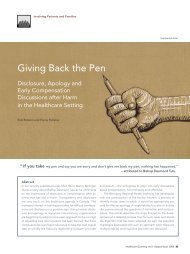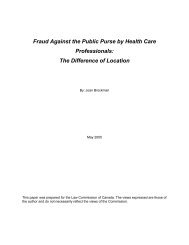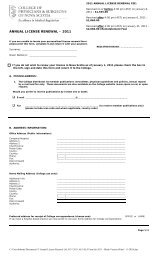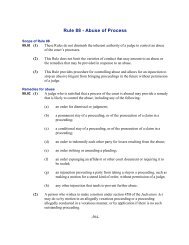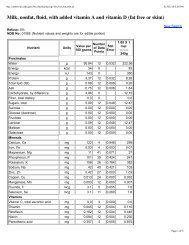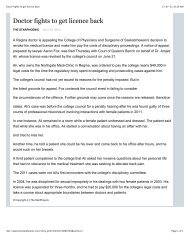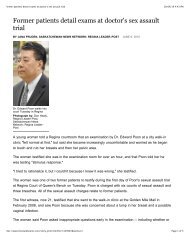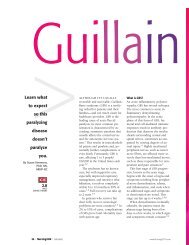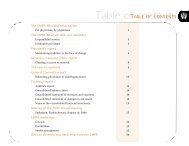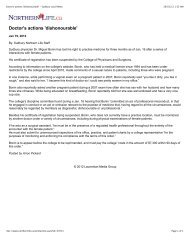Experiments That Changed Nutritional Thinking - TUUM EST
Experiments That Changed Nutritional Thinking - TUUM EST
Experiments That Changed Nutritional Thinking - TUUM EST
You also want an ePaper? Increase the reach of your titles
YUMPU automatically turns print PDFs into web optimized ePapers that Google loves.
1034S<br />
SUPPLEMENT<br />
demiological observations with respect thereto. Public Health Rep. 29: 1683– anemic animals by dietary methods, however. In the preceding<br />
1686.<br />
Goldberger, J. (1916) The transmissibility of pellagra: experimental attempts<br />
paper in their series, data were presented showing that iron<br />
at transmission to the human subject. Public Health Rep. 31: 3159–3173. salts of great purity were ineffective in correcting an anemia<br />
Goldberger, J. & Schamberg, J. F. (1909) Epidemic of an urticarioid dermatitis of rats confined to a diet of cow’s milk. However, an equal<br />
due to a small mite (Pediculoides ventricosus) in the straw of mattresses.<br />
amount of iron fed as ash of lettuce, corn or beef liver (an<br />
Pub. Health Rep. 24: 973–975.<br />
Goldberger, J. & Sebrell, W. H. (1930) The black tongue preventive value of acid extract of ash) was very potent in restoring normal hemo-<br />
Minot’s liver extract. Public Health Rep. 45: 3064–3070.<br />
globin.<br />
Goldberger, J. & Tanner, W. F. (1922) Amino acid deficiency probably the etio-<br />
The seventh paper (Hart et al. 1928) in their series establogic<br />
factor in pellagra. Public Health Rep. 37: 462–486.<br />
Goldberger, J., Waring, C. H. & Willets, D. G. (1915) A test of diet in the prevention<br />
of pellagra. South. Med. J. 8: 1043–1044.<br />
were modest, concluding only that the experiments ‘‘point to<br />
lished copper as an essential nutrient. Although the authors<br />
Goldberger, J., Wheeler, G. A. & Sydenstricker, E. (1918) A study of the diet<br />
the need for a more intensive study of the rôle of small amounts<br />
on nonpellagrous and of pellagrous households in textile mill communities in<br />
South Carolina in 1916. J. Am. Med. Assoc. 71: 944–949.<br />
of inorganic substances in the diet,’’ McCollum (1957) suggests<br />
Krehl, W. A., Tepley, L. J., Sarma, P. S. & Elvehjem, C. A. (1945) Growth re- that this experiment and other similar ones on trace elements<br />
tarding effects of corn in nicotinic acid–low rations and its counteraction by ‘‘broadened immensely the outlook of physiologists, biochemtryptophan.<br />
Science 101: 489–491.<br />
Siler, J. F., Garrison, P. E. & MacNeal, W. J. (1914) Pellagra, a summary of the<br />
ists, and pathologists.’’<br />
first progress report of the Thompson-McFadden Commission. J. Am. Med. Figure 1 contains charts on six rats of some 50 presented.<br />
Assn. 62: 8–12.<br />
Each chart showed both rat weight and hemoglobin plotted<br />
Tanner, W. F. (1921) Progress report to Goldberger (unpublished and cited by<br />
Hundley in Sebrell, W. H. & Harris, R. S. (1954) The Vitamins: Chemistry,<br />
against time. Intakes of 0.3 g of Cohn’s liver preparation (ap-<br />
Physiology, Pathology, Volume II, page 553. Academic Press, New York, NY. proximately equivalent to 1.7 g of dried beef liver) produced<br />
Terris, M. (1964) Goldberger on Pellagra. Louisiana State University Press, a ‘‘marked growth response’’ in rat 597 without much improve-<br />
Baton Rouge, LA.<br />
ment in hemoglobin. Cohn et al. (1927) fractionated livers<br />
Vilter, R. W., Mueller, J. F. & Bean, W. B. (1949) The therapeutic effect of trypto<br />
produce extracts more efficacious than whole liver in curing<br />
tophan in human pellagra. J. Lab. Clin. Med. 34: 409–413.<br />
Willets, D. G. (1915) The treatment of pellagra by diet. South. Med. J. 8: 1044– anemia. Rat 596 responded with improved hemoglobin when<br />
1047.<br />
given 0.5 mg of iron. Thus bioassay confirmed that the liver<br />
preparation was low in iron as shown by chemical analysis.<br />
Paper 10: Copper as a Supplement to The response of rat 615 was similar to that of rat 596 when<br />
ash of the liver preparation was fed with iron, thereby exclud-<br />
Iron for Hemoglobin Building in the Rat<br />
ing ‘‘the existence of an organic factor’’ being of benefit in<br />
(Hart et al., 1928)<br />
these experiments.<br />
Because several types of ash had been found ‘‘very potent<br />
Presented by Leslie M. Klevay, U.S. Department of Agriculture,<br />
in restoring to normal the hemoglobin,’’ an attempt to frac-<br />
Grand Forks Human Nutrition Research Center, Grand Forks,<br />
tionate the ash was made ‘‘quite early in our experiments.’’<br />
ND 58202 as part of the minisympsosium ‘‘<strong>Experiments</strong> <strong>That</strong><br />
All experiments were done with the same iron intake. Rat<br />
<strong>Changed</strong> <strong>Nutritional</strong> <strong>Thinking</strong>’’ given at Experimental Biology 95,<br />
620 had improved hemoglobin with an acid extract of ash,<br />
April 11, 1995, in Atlanta, GA.<br />
indicating that the effective ‘‘substance (or substances)’’ were<br />
Although Hopkins (1906) and Funk (1912) shrewdly pretionation<br />
‘‘more dramatic,’’ they treated this acid extract with<br />
soluble in hydrochloric acid. Deciding to make their ash fracdicted<br />
early in the 20th century that some diseases occurred<br />
because of dietary deficiency of accessory or essential food hydrogen sulfide. The hemoglobin of rat 690 was restored by<br />
factors, the observations they cited were ‘‘unknown to medical the ‘‘small but distinct precipitate of sulfides.’’ After this premen<br />
and chemists of that period’’ (McCollum 1957). Physiolonia<br />
and ammonium sulfide; rat 688 died without improvement<br />
cipitate was ‘‘filtered off,’’ the filtrate was treated with ammo-<br />
gists, biochemists and even the public (Allen 1931) caught<br />
up by 1928. Many important discoveries on the role of organic of hemoglobin when given this second precipitate. Thus, it<br />
nutrients were made in the 1920s because Hopkins and Funk was found that the active element had an acid-insoluble sul-<br />
had opened their eyes (McCollum 1957).<br />
fide; other elements besides copper were possible (Sorum<br />
The 1926 edition of Osler’s influential textbook (Osler and 1949). Acid ‘‘extracts of the ash of lettuce . . . could not<br />
McCrae 1926) listed two classes of anemia. The secondary or be separated sharply into an active and inactive fraction by<br />
symptomatic class included those due to blood loss, infection precipitation with ammonia.’’<br />
or intoxication. The primary or essential class included only The chronology of these experiments is not obvious. Perhaps<br />
chlorosis, pernicious anemia and sickle cell anemia. Of these the rat number can be a guide. ‘‘Shortly before the time’’ that<br />
three, only chlorosis had an effective treatment. Osler referred the fractions of the Cohn preparation were studied, a trial of<br />
to the treatment of chlorosis by iron therapy as ‘‘one of the copper was made. Figure 2 shows the response of rat 621, the<br />
most brilliant instances—of which we have but three or rat from which the essentiality of copper can be inferred. When<br />
four—of the specific action of a remedy’’ and stated ‘‘It is a supplemental iron with copper was begun, growth had ceased<br />
minor matter how iron cures chlorosis.’’ Osler did not infer the and hemoglobin was 2.68 g/dL. Growth resumed and hemoglobin<br />
existence of iron deficiency anemia (chlorosis was of unknown increased to 9.35 in 2 wk, 10.9 after 6 wk and then reached 13.3<br />
cause). Anemias from deficiency of ascorbic acid, cobalt, folate, g/dL. ‘‘Without the copper addition, the rise in hemoglobin would<br />
niacin, pantothenic acid, pyridoxine, riboflavin, thiamine, via<br />
single animal but the effect was so convincing and helpful’’<br />
not have occurred.’’ ‘‘This preliminary experiment was with but<br />
tamin E, etc., were unrecognized (Wintrobe 1967).<br />
Hart, Steenbock, Waddell and Elvehjem certainly were well that the chart is recorded ‘‘if for no other reason than its historical<br />
informed about nutritional opportunities and contemporary interest.’’ A dozen other rats were studied at three doses of copper.<br />
nutritional knowledge; they may have been somewhat ahead Response to 0.01 mg of copper was less rapid than the response<br />
of physicians who read Osler. Their experimental design refound<br />
in the ash of the liver preparation.<br />
to 0.05 or 0.1 mg. The intermediate dose was similar to that<br />
sembled that of Whipple et al. (1920), who used phlebotomy<br />
to make dogs anemic and then measured blood regeneration to The authors knew that copper occurs in plant and animal<br />
assay dietary components for nutritional value. They produced tissues, but ‘‘no definite function has been assigned to it except<br />
/ 4p09$$0062 04-07-97 14:02:12 nutras LP: J Nut May Suppl<br />
Downloaded from jn.nutrition.org by on June 3, 2010



